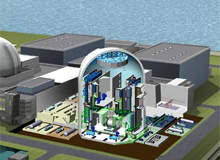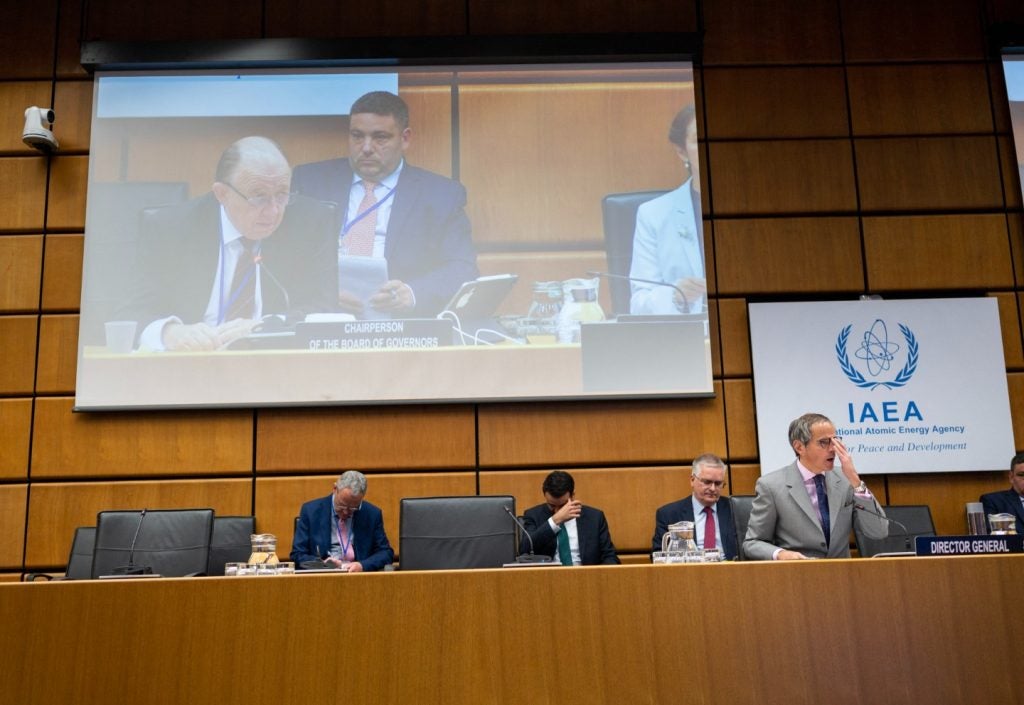
The UK government had a decision to make. With natural energy stocks like oil and gas dwindling, fears over security of energy supply between nations after Russia turned off a gas pipe to Ukraine in 2006 and increasing pressure to solve the problem of climate change, an energy solution needed to be found that tackled all three issues head-on. The question was what?
The solution, it appears, was staring us in the face. After years of being denounced as the great evil following disasters at Three Mile Island in 1979 and Chernobyl in 1986, nuclear power was declared ‘safe and affordable’ in January 2008 by business secretary John Hutton, when he announced that the government had given the go-ahead for a new wave of nuclear power stations to be built in the UK.
“Set against the challenges of climate change and security of supply, the evidence in support of new nuclear power stations is compelling,” Hutton told Parliament. “We should positively embrace the opportunity of delivering this important part of our energy policy.”
The UK currently has 20 nuclear reactors, which supply 18% of the country’s electricity. Nearly half of these are already closed, with four due to be decommissioned by 2015 and five more by 2025.
However, following Mr Hutton’s announcement, it is anticipated that ten new plants could now be built in the UK by 2020.
So who is going to build them? Who is going to pay for them? And what does this mean for the future of British power?
How well do you really know your competitors?
Access the most comprehensive Company Profiles on the market, powered by GlobalData. Save hours of research. Gain competitive edge.

Thank you!
Your download email will arrive shortly
Not ready to buy yet? Download a free sample
We are confident about the unique quality of our Company Profiles. However, we want you to make the most beneficial decision for your business, so we offer a free sample that you can download by submitting the below form
By GlobalDataPOTENTIAL NUCLEAR PLANT CONTRACTS
No new nuclear power stations have been built in Britain since Sizewell B in the 1980s. So, when Mr Hutton told MPs in January that he would “invite energy companies to bring forward plans to build and operate new nuclear power stations”, it sparked a mad scramble for contracts.
Within hours, French company Areva announced plans to build six new nuclear power stations in the UK, four of them in partnership with EDF, the world’s largest nuclear operator. The company aims to have its first new British site on stream by 2017.
Centrica, the owner of British Gas, announced it would consider equity investments in the new plants and would also be interested in buying electricity from them.
German companies E.On and RWE, which own Powergen and npower in Britain, are also keen to be involved.
British Energy, the only indigenous company big enough to be part of the new nuclear Britain, said it would announce its proposals in March. With the British Government likely to look favourably on a homegrown candidate and the fact that three of the four most likely sites for new nuclear plants – Sizewell in Suffolk, Dungeness in Kent and Hinkley Point in Somerset – are controlled by British Energy, the company appears to be in a strong bargaining position, particularly after securing additional capacity from the National Grid to power new nuclear plants at those sites.
However, those looking to nuclear for a quick fix will be disappointed. No contracts have been signed so far and it isn’t thought possible to get a new plant on stream before 2017.
“Nothing’s been signed yet,” says Steven Knell, energy analyst at Global Insight. “The European companies had been circling the UK market for a while. They’ve made their overtures but certain problems remain, like where the sites will be and how the public will respond. We are looking at a pretty lengthy timetable on this.”
EXPECTED SITES AND INVESTMENT
For convenience and finance’s sake, it is expected that Britain’s new plants will be built on or close to existing nuclear sites. Because of the high demand for power in the south east and London, Bradwell in Essex will join Sizewell, Dungeness and Hinkley Point as the most likely sites in England, closely followed by Wylfa in Anglesey, Hartlepool and Heysham.
The two Scottish sites at Hunterston and Torness would be obvious candidates but the pro-oil and gas Scottish National Party has threatened to block their development, citing nuclear waste and the need to move towards renewable energies as their main concerns.
Not only does building a nuclear power plant require a huge capital outlay – construction estimates for the new plants come in at £8.6bn each – long construction periods also mean there is a significant time lag before any revenue is returned.
Servicing the capital costs is therefore hugely important.
Although they have suggested that tax breaks may be an option to allay the huge costs of decommissioning the UK’s old nuclear stations, the government has ruled out subsidising the new builds. So who is going to pay for them?
“The government has hinted in the fine print of this announcement that there will be some public sector support, particularly with regards to decommissioning and waste issues,” says Knell.
“They have also given assurances about carbon prices, which is a move to assure the city that this is a safe investment. I have no concerns about the ability to raise funds for this and I think we’ll see some interesting investment strategies to compensate for the time lags in construction.”
NEW NUCLEAR TECHNOLOGY
In May 2007 the UK government issued a consultation document entitled ‘the future of nuclear power’, in which it invited applications from vendors of nuclear reactors interested in having their designs assessed ahead of any potential nuclear green light. Two months later it was revealed that four applications had met the initial criteria and would move on to face further assessment to see if they were suitable to become part of Britain’s new nuclear stable.
Most reactors in the UK at present are Magnox or advanced gas-cooled reactors [AGRs], which are generation I and II designs; the majority of which are heading towards the end of their 40-year shelf lives. The designs currently under assessment by the UK government are generation III+, which are generally more efficient in terms of waste and cost, and are quicker to build than the old plants.
There are four of these generation III+ designs under consideration at present.
AREVA EPR
Areva’s EPR [European Pressurised Reactor] is the daddy of all reactors, packing an impressive 1,600MW of power. A pressurised water reactor [PWR], the EPR offers lower power generation costs because it uses less fuel than other reactors and would be operational for 92% of its 60-year life, according to Areva.
The first EPR is being built in Olkiluoto in Finland and is expected to be operational by 2011. Construction on the second, at Flamanville 3 in France, began in 2007. Although the Finnish site has been beset by delay, Areva hopes that by the time they come to the UK, EPRs will take three-and-a-half years to build.
WESTINGHOUSE AP1000
The byword for Westinghouse’s AP1000 is efficiency. Compared with reactors that produce the same amount of power, they use 50% fewer valves, 35% fewer pumps, 70% less cabling and can be contained in a building almost half the size.
Subsequently, the 1,117MW PWR, which has a design life of 60 years, can be built in less than three years. The AP1000 is currently the only generation III+ design to be licensed by the US Nuclear Regulatory Commission. Westinghouse has been awarded a contract to build a number of the power plants in China.
CANDU ACR1000
The Candu ACR100 is a 1,200MW pressurised heavy water reactor [PHWR]. It promises to spend less time offline than its competitors, due to its horizontal fuel channels, which allow the reactor to be refuelled with enriched uranium whilst it is still generating heat to power the steam generators.
The ACR1000 is manufactured by Atomic Energy of Canada Ltd and has a design life of 60 years. With a projected construction time of three and a half years, the first ACR1000 is expected to be on stream in Canada by 2014.
GE ESBWR
The key feature of the Economic Simplified Boiling Water Reactor [ESBWR] is its hardiness. Built to withstand earthquakes, hurricanes and tornadoes, the manufacturers of the 1,560MW reactor say the outer shell is tough enough to withstand the impact of an aircraft collision.
The ESBWR, which has a design life of 60 years and can be built in three, is currently going through the US design certification process. Manufacturers General Electric / Hitachi are hopeful that the reactor will be in commercial operation by 2015.
THE FUTURE OF NUCLEAR ENERGY
Driven by public mistrust and lack of investment, the UK nuclear market had been on the wane for years. Its main player, British Energy, was in such disarray in 2004 that it delisted its shares from the London stock exchange. However, the government’s backing for nuclear fuel will spark a renaissance for the industry and has already fuelled something of a land grab with French companies EDF and Areva, German giants E.ON and RWE and a revitalised British Energy drawing battle lines in the sand.
“Nuclear was written off throughout the 1980s and 1990s,” says Global Insight’s Knell. “Public confidence was badly affected by Chernobyl. However, nuclear is going to experience a renaissance that will trigger an increase in investment and confidence. Those people that were counting on the decline of nuclear power should think again. It provides an old solution to a new problem.”
The UK’s oil and gas industry has a finite shelf-life. When the natural reserves are used up, sometime in the next 30 years, Britain faces a hole in its energy resource that cannot be filled by renewable sources alone. The government hopes that nuclear will fill the power vacuum created by the collapse of the indigenous oil and gas industry, while helping the UK cut carbon dioxide emissions to the desired 1990 levels of 60% by 2050.
Although the move to nuclear will ensure the laptops and light bulbs of Britain continue to run, it may not prove to be such good news on the supply side.
British Energy, although recovered from its dark times of 2004, is nowhere near as powerful as overseas giants like EDF and E.ON. The UK’s move to nuclear could well pave the way for foreign energy giants to tighten their stranglehold on the British energy market.
“The British market has withered over the years but my worry is more about international capacity,” says Knell. “China, India and some of the smaller nations like Thailand are all going to want new builds to expand or establish their nuclear power capabilities. That will put pressure on the uranium reserve base, which hasn’t happened before. It could lead to massive increases in price.
“[There is also the question of] who is going to do the work. There are so few international contractors in the market it could cause a bottleneck.”






